For the 2025 school year, there is 1 public preschool serving 537 students in South Dearborn Community Sch Corp School District. This district's average pre testing ranking is 3/10, which is in the bottom 50% of public pre schools in Indiana.
Public Preschool in South Dearborn Community Sch Corp School District have an average math proficiency score of 28% (versus the Indiana public pre school average of 43%), and reading proficiency score of 36% (versus the 39% statewide average).
Minority enrollment is 7% of the student body (majority Black and Hispanic), which is less than the Indiana public preschool average of 36% (majority Hispanic).
Overview
This School District
This State (IN)
# Schools
5 Schools
605 Schools
# Students
1,878 Students
264,424 Students
# Teachers
137 Teachers
17,629 Teachers
Student : Teacher Ratio
14:1
14:1
District Rank
South Dearborn Community Sch Corp School District, which is ranked within the top 50% of all 394 school districts in Indiana (based off of combined math and reading proficiency testing data) for the 2021-2022 school year.
The school district's graduation rate of 75-79% has decreased from 90% over five school years.
Overall District Rank
#193 out of 400 school districts
(Top 50%)
(Top 50%)
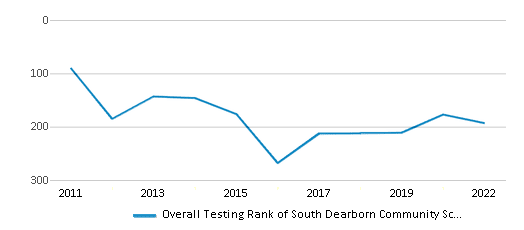
Math Test Scores (% Proficient)
31%
38%

Reading/Language Arts Test Scores (% Proficient)
43%
41%
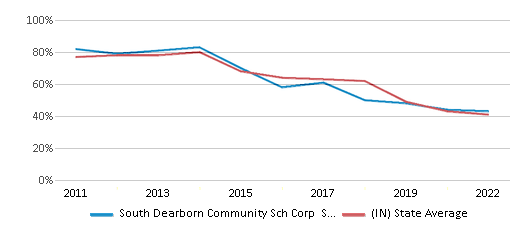
Science Test Scores (% Proficient)
30%
34%
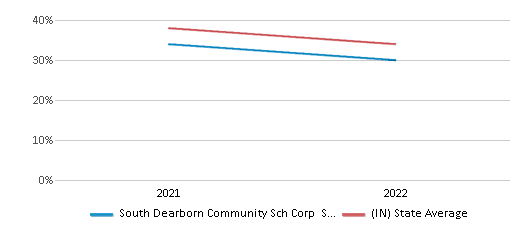
Graduation Rate
75-79%
88%
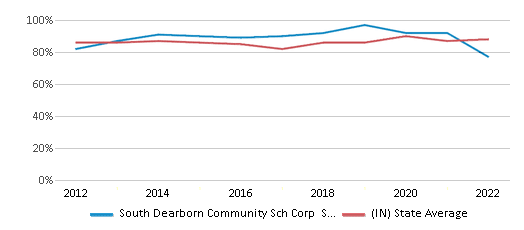
Students by Ethnicity:
Diversity Score
0.11
0.56
# American Indian Students
2 Students
409 Students
% American Indian Students
n/a
n/a
# Asian Students
6 Students
7,922 Students
% Asian Students
n/a
3%
# Hispanic Students
29 Students
39,591 Students
% Hispanic Students
2%
15%
# Black Students
18 Students
30,755 Students
% Black Students
1%
12%
# White Students
1,776 Students
169,241 Students
% White Students
95%
64%
# Hawaiian Students
1 Student
312 Students
% Hawaiian Students
n/a
n/a
# Two or more races Students
46 Students
16,194 Students
% of Two or more races Students
2%
6%
Students by Grade:
# Students in PK Grade:
46
22,837
# Students in K Grade:
124
40,190
# Students in 1st Grade:
140
40,513
# Students in 2nd Grade:
110
40,311
# Students in 3rd Grade:
115
37,170
# Students in 4th Grade:
139
37,119
# Students in 5th Grade:
125
27,784
# Students in 6th Grade:
141
11,600
# Students in 7th Grade:
149
1,191
# Students in 8th Grade:
144
1,197
# Students in 9th Grade:
178
1,093
# Students in 10th Grade:
157
1,194
# Students in 11th Grade:
169
1,100
# Students in 12th Grade:
141
1,012
# Ungraded Students:
-
113
District Revenue and Spending
The revenue/student of $15,596 is higher than the state median of $13,222. The school district revenue/student has grown by 11% over four school years.
The school district's spending/student of $15,397 is higher than the state median of $12,852. The school district spending/student has grown by 11% over four school years.
Total Revenue
$29 MM
$13,615 MM
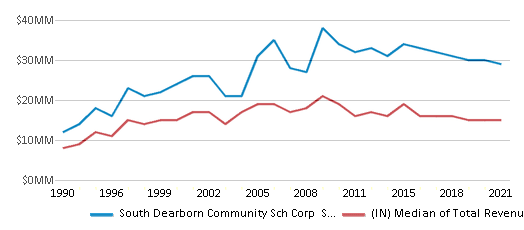
Spending
$29 MM
$13,234 MM
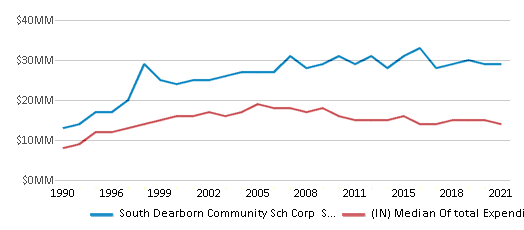
Revenue / Student
$15,596
$13,222

Spending / Student
$15,397
$12,852
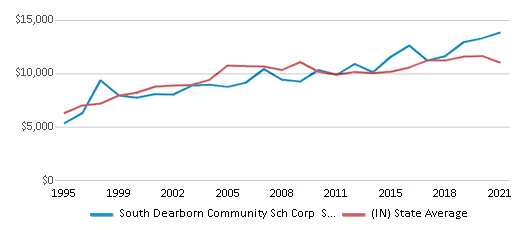
Best South Dearborn Community Sch Corp School District Public Preschools (2025)
School
(Math and Reading Proficiency)
(Math and Reading Proficiency)
Location
Grades
Students
Rank: #11.
Aurora Elementary School
(Math: 28% | Reading: 36%)
Rank:
Rank:
4/
Bottom 50%10
6098 Squire Pl
Aurora, IN 47001
(812) 926-2222
Aurora, IN 47001
(812) 926-2222
Grades: PK-6
| 537 students
Recent Articles

Year-Round Or Traditional Schedule?
Which is more appropriate for your child? A year-round attendance schedule or traditional schedule? We look at the pros and cons.

Why You Should Encourage Your Child to Join a Sports Team
Participating in team sports has a great many benefits for children, there is no doubt. In this article you will learn what those benefits are.

White Students are Now the Minority in U.S. Public Schools
Increasing birth rates among immigrant families from Asia and Central and South America, combined with lower birth rates among white families, means that for the first time in history, public school students in the United States are majority-minority. This shift in demographics poses difficulties for schools as they work to accommodate children of varying language abilities and socio-economic backgrounds.





